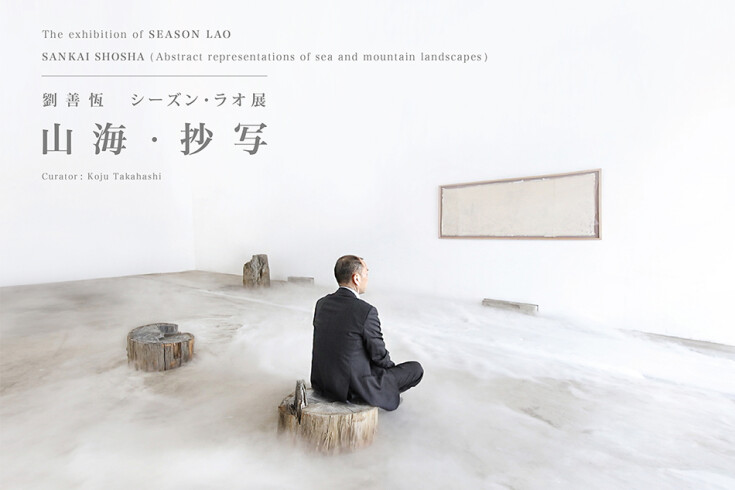
《山海・抄写 SAN KAI SHOSHA》2022 Apr – Solo Exhibition – Gallery Garage Kyoto, Japan
Exhibition
Date : 2022.4.8-25
City : Kyoto, Japan
Venue : Gallery Garage
〒601-8022 京都府京都市南区東九条北松ノ木町7-1
7-1 Higashikujo Kitamatsunoki-cho, Minami-Ku, Kyoto
The exhibition of SEASON LAO
SAN KAI SHOSHA ( Abstract representations of sea and mountain landscapes )
《 山海・抄写 》 劉 善 恆 シ ー ズ ン・ラ オ 展
Curator : Koju Takahashi
虚室・生白 (きょしつしょうはく)
「虚室・生白」は老莊思想の言葉、表の意味はがらんとした部屋には白い光が射し込むと自然に明るくなる。実際に心に何の迷いもなければ、「道」を悟り智慧を生む澄んだ境地のことを指す。
ラオ氏の作品は東洋的イデア論とも言える「天人合一」思想に基づいた「余白」による美的概念を表現している。余白の美は、東洋における美意識の最たる特徴の一つである。霧や雪、または虚空などで表現されることが多い「余白」という空間は、時に描かれているモティーフを超えた事物を観者に予感させる。この余白の美からは単純な風景とはまた違う、非常な深みと安らぎが感じられる。これは、観者がその「余白」に対して何らかの解釈を試みる際、補足として自己の体験や心的世界を投げ入れることで、作品世界と反省的に一体となるからではないだろうか。
また「余白」がもたらす空気感は、主観主義的判断に定位した美ではなく、常に観者側に開かれた美となり、観る者を許容し、鑑賞する私たちを桃源郷「理想郷」に招き入れる。
例えば幸田露伴の著書に「観画談」というものがある。作中の主人公はこのプロセスにより画中の人物に呼ばれる体験から、あちら側と一体となる様が描かれているが、このような 神仙的世界観はまさしく「天人合一」に基づくものである。芸術においては、対象化された作品と観者との一対一の関係を軸とする美学ではなく、あくまでも観者が作品世界と融和する美学であり、古来よりとくに老荘思想内で構想されてきたものであることが解される。
An Empty Room Turns White For Enlightenment | SEASON LAO Installation
“虚室・生白 Kyoshitsu Shohaku” (An Empty Room Turns White For Enlightenment) is a concept from Taoist philosophy, meaning that when white light shines into an empty room,
it naturally becomes brighter. It refers to a clear state where there is no hesitation in the mind, a sense of enlightenment of the “way” that leads to a birth of wisdom.
Season Lao’s work strives to express the aesthetic concept of “blank white space” based on the concept of “the unification of man with the nature” that could be described as central to Eastern philosophy. The beauty of blank white space is one of the most important aspects of aesthetic awareness in Eastern thought. These blank white spaces, often depicted using fog, snow, or simple emptiness, provide the onlooker with a feeling that there is something that extends far beyond the motifs that are frequently depicted. From the beauty of these empty spaces, one can gain a great sense of depth and comfort different from that conveyed by simple landscape art. Perhaps because the person viewing the art always tries to interpret these blank white spaces in some way, filling in the void with personal experiences and his or her own internal world, such are offers opportunities to become one with the artwork through personal involvement.
In addition, the impression of open air conveyed by the empty spaces is not a localized beauty based in subjective judgment, but rather a beauty always available and open to the viewer, inviting the person viewing the artwork to appreciate its hidden paradise (utopia).
One example is Kouda Rohan’s “Kangadan.” The book describes the protagonist’s experience of being called by a character in a painting and becoming one with the painting. This kind of mystical worldview is based on “the unification of man with the nature.” In art, this is not an aesthetic revolving around the one to one relationship between the work in question and the viewer, but rather an aesthetic of the spectator becoming one with the world of the artwork, and it is understood to have been conceived by the ancient Taoists.
本展では、マカオ出身の国際的に活躍するアーティストであるシーズン・ラオ氏による作品を中心に、東アジアに古来より見られる自然思想と、これに由来する美意識の一つである「余白」の美を考察することを試みます。会場では、ラオ氏と親交がある日本人作家の立体作品も設置し、それらを山水と見立て、静謐なインスタレーションを通してひとつの風景を構築します。
In this exhibition, we focus on the artworks of Season Lao, an artist from Macao, successful worldwide. And we try to inquire into the idea of nature, which we can see since time immemorial in East Asia, and the beauty of blank spaces, which is one of the senses of beauty based on this idea of nature. At the venue, three-dimensional artworks by Kuranuki Toru and Arima Shimpei, friends of Season Lao, have also been installed. These works are likened to mountains and water, and through these installation artworks of peace and tranquility, they form a single landscape.
探幽するシーズン・ラオ
シーズン·ラオ氏の平面の作品に雪景をモティーフとした写真シリーズがある。作品はまるで訪ねた事のない場所にも関わらず、観る者に自らの故郷から届いたかのような郷愁を感じさせる。また実際の取材方法や素材選択は、例えば手鑑をつくる際に古今東西の書画から抄写するような、事物の背後に対する敬意や配慮が見受けられる。ラオ氏は制作取材の際、紡がれるように繋がってゆく旅中での人や地との縁、降雪などの偶発性、あるいは雪解けまでの自然現象による限られた時間的要素といった非再現性(天)を最も重要視する。
こういった「縁」や「天」は、客体·総体的関係性から真理を探求するといった、東洋的思想の一部を反映しているのではいないだろうか。
ラオ氏のこうした制作理念は人間の制御を超越した自然の真理性と深く結びつき、人に崇高なる印象を与える。その印象はたとえ一瞬で消失する淡雪によるものであったとしても、何らかの理想を含んでいるのであり、まさしく桃源郷と呼ばれようものである。そしてこの刹那の自然から受ける桃源郷的印象は、消えゆく我々の美意識であるがゆえに郷愁を感じるのだ。
Exploring Season Lao
Season Lao’s two dimensional works include a series of images around the motif of snow scenes. Despite these being taken in places the viewer has never visited, it still somehow engenders a sense of nostalgia as if arriving in one’s own hometown. The actual gathering and selection of materials is done with respect and consideration for the background of things, as though transcribing excerpts from paintings and calligraphic works from various times and places to create a collection of writings.
When gathering materials to create a piece, what Season Lao regards the most highly is the fated connections with people and places that are woven together on the journey, eventualities like snowfall, and the temporal elements of nature that can’t be recreated, such as the time until the snow melts. Perhaps these elements of “fate” and “nature” reflect part of the Eastern philosophy of searching for truth in holistic, objective connections.
Season Lao’s artistic philosophy is linked closely and deeply to the truth of nature that transcends human control and conveys this sublime impression to human beings. Even if such an impression is conveyed using light snow that soon melts and disappears, some sort of ideal is transmitted, the sort of hidden paradise previously mentioned. It is from the impression of this hidden paradise through a transient natural moment that creates nostalgia within us due an aesthetic sense of disappearance.
Trackback from your site.

























